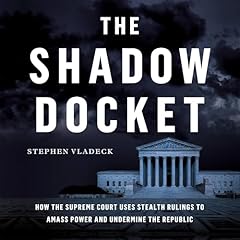
Injustices
The Supreme Court's History of Comforting the Comfortable and Afflicting the Afflicted
No se pudo agregar al carrito
Add to Cart failed.
Error al Agregar a Lista de Deseos.
Error al eliminar de la lista de deseos.
Error al añadir a tu biblioteca
Error al seguir el podcast
Error al dejar de seguir el podcast
Obtén 3 meses por US$0.99 al mes
 Exclusivo para miembros Prime: ¿Nuevo en Audible? Obtén 2 audiolibros gratis con tu prueba.
Exclusivo para miembros Prime: ¿Nuevo en Audible? Obtén 2 audiolibros gratis con tu prueba.
Compra ahora por $15.47
-
Narrado por:
-
Joe Barrett
-
De:
-
Ian Millhiser
Few American institutions have inflicted greater suffering on ordinary people than the Supreme Court of the United States. Since its inception the justices of the Supreme Court have shaped a nation where children toiled in coal mines, where Americans could be forced into camps because of their race, and where a woman could be sterilized against her will by state law.
In this powerful indictment of a venerated institution, Ian Millhiser tells the history of the Supreme Court through the eyes of the everyday people who have suffered the most from it. America ratified three constitutional amendments to provide equal rights to freed slaves, but the justices spent 30 years largely dismantling these amendments. Then they spent the next 40 years rewriting them into a shield for the wealthy and the powerful. In Injustices, Millhiser argues that the Supreme Court has seized power for itself that rightfully belongs to the people's elected representatives and has bent the arc of American history away from justice.
©2015 Ian Millhiser (P)2015 TantorLos oyentes también disfrutaron:




















Reseñas de la Crítica
Good research but very demoralizing
Se ha producido un error. Vuelve a intentarlo dentro de unos minutos.
Great read!
Se ha producido un error. Vuelve a intentarlo dentro de unos minutos.
Very educational.
Se ha producido un error. Vuelve a intentarlo dentro de unos minutos.
An important history of SCOTUS extremism
Se ha producido un error. Vuelve a intentarlo dentro de unos minutos.
Good but depressing
Se ha producido un error. Vuelve a intentarlo dentro de unos minutos.


